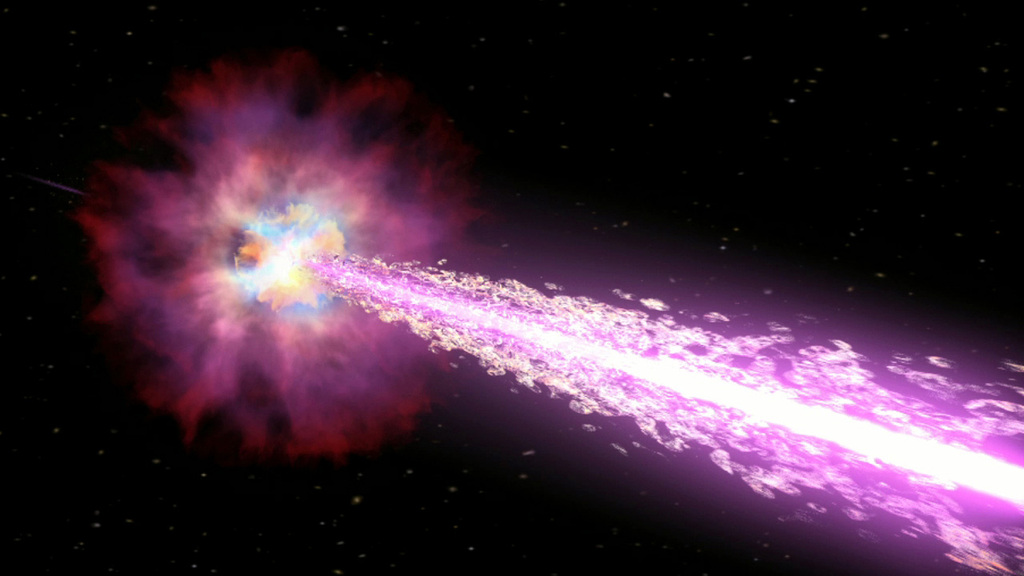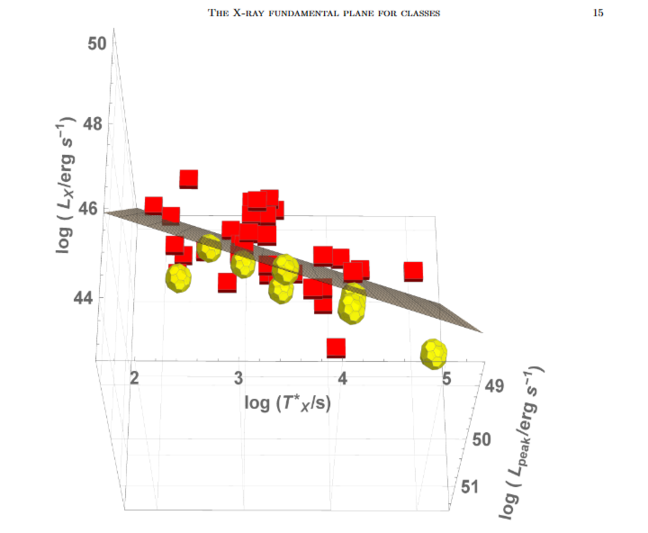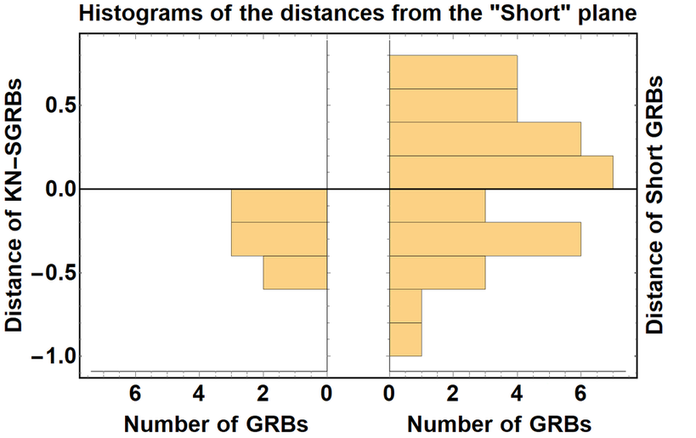Astronomy Object of the Month: 2020, November
< previous Archive next >
Neil Gehrels Swift Observatory Gamma-Ray Burst associated with Kilonovae: ambushing the Standard Candle in its own nest
Gamma-Ray Bursts (GRBs) are the most luminous and explosive transient phenomena in the Universe after the Big Bang, but they are still puzzling phenomena regarding their emission mechanism even after more than 50 years from their discovery. A powerful tool for characterizing and classifying GRBs to allow them to be used as tracers of the expansion history of the Universe and to understand their mysterious and debated physical mechanisms has been recently presented by an international team of researchers led by Dr. hab. Maria Dainotti, Assistant Professor at Jagiellonian University, Poland and concurrently serving as Senior Research Scientist at RIKEN and affiliate Research Scientist at Space Science Institute, in Boulder, Colorado.

The new article, which has been accepted by the Astrophysical Journal, pays particular attention to the GRBs associated with Kilonovae, and to a sample called the Platinum sample for which the maximum redshift observed is 5, much more distant than the maximum redshift at which the SNe Ia have been observed.
Astronomers can only directly measure distances to objects that are close to Earth and can extrapolate the distances to objects farther out. All the objects that serve as rungs on the cosmological distance ladder have known luminosities and are referred to as "standard candles". Once the absolute luminosity of the standard candle is known, the distance to that object can be calculated based on its measured brightness. For example, the light of the same standard candle will appear dimmer when it is farther away. GRBs are so powerful that in a few seconds they emit the equivalent of the energy emitted by the Sun during its entire lifetime. Thus, it is possible to observe GRBs at incredibly large distances (a.k.a., high redshift), much further than standard candles like Ia-type supernovae (SNe Ia) that are observed at up to 11 billion light years. Using GRBs as a new type of standard candle will allow astronomers to study and comprehend cosmological issues that could change current models regarding the Universe's history and its evolution.
Despite decades of observations, a comprehensive model able to explain the underlying physical mechanisms and properties of these objects has not been reached yet. Many possible physical origins for GRBs have been proposed, like the explosion of an extremely massive star (the long duration GRBs) or the merging of two compact objects (the short duration GRBs). Many models about the progenitor responsible of powering GRBs have been proposed as well, such as a black hole, a neutron star (NS) or a rapidly rotating newly born NS with a high magnetific field (magnetar).
Kilonovae (in short: KNe) are astrophysical objects linked to short duration gamma-ray bursts, which are the result of explosions occuring after two very dense objects (for exampe, two neutron stars) merge together. The detection of X-ray emission at a location coincident with the given Kilonovae can also provide the missing observational link between short duration GRBs and gravitational wavesproduced by ssuch stellar mergers. The first detection of the Kilonovae associated with both gravitational waves emission and such a short GRB, namely GRB 170817, has opened a new era of observations and theoretical investigation. The missing piece to this long-standing story is the connection of KNe and the GRB observational correlations that Dainotti et al. now provide.

Even when all the GRBs are observed with the same satellite, in this case the NASA's Neil Gehrels Swift Observatory, the GRBs' features are seen to vary very widely over several orders of magnitude. This applies not only to the prompt emission (the main event in the gamma rays), but also to the extended afterglow phase (which follows the prompt emission and is seen over a wide range of wavelengths). Thus, the key point of the article by Dainotti et al., is the hunt for features which remain invariant according to peculiar classes of GRBs.

The team has found a 3-D correlation, i.e. a link between the following three variables that identifies a plane: duration of the X-ray plateau phase, its luminosity, and the luminosity of the peak prompt gamma ray feature. The distances of GRBs from a given class's plane allowed the authors to determine if GRBs belong to that particular class by showing different features related to this 3-D correlation. The Dainotti et al. study has also shown that although the GRBs-KNe events are a subsample of the larger class of short duration GRBs (red cuboids), they show some observational peculiarities: indeed, they all lie below the short fundamental plane as shown in Figure 2 (yellow truncated icosahedrons). In this analysis, selection biases and evolutionary effects (namely, how the variables change with distance or redshift) have been accounted for, and after correction for selection bias the 3D correlation for GRB-KNe is still tight together with the platinum sample, the tightest sample for the 3D correlation where only well-sampled determined features are taken into account. Thus, both the platinum and the GRBs-KNe plane seems to be the excellent tools for further cosmological studies.
In fact, the GRBs-KNe plane has the smallest observed distance from its plane, called the intrinsic scatter. Here this scatter is 29% smaller than a previous analysis, see Fig. 2, object of a NASA press in 2016, lead by Dr. Dainotti. We note that this finding has been reached in a natural way without assuming any observational criteria, as had been done in Dainotti et al.
In addition, the separated KNe plane itself still has a very small distance from the 3D plane related to the KNe when evolution is accounted for, see Fig. 3. The smaller the distance is from the plane, the more useful the plane is to be used as a cosmological tool.
A great advantage of using the GRBs associated with Kilonovae is that the GRB-KNe events have a clearer physical emission process compared to other observational GRB classes. Thus, the leap forward in this study is that this sample has a physical grounding related to the fundamental plane relation regardless of the features of the plateau phase which can vary widely from one GRB to another.
Original publication: Prof. Maria Giovanna Dainotti, Aleksander Lenart, Giuseppe Sarracino, Shigehiro Nagataki, Salvatore Capozziello, Nissim Fraija; The X-ray fundamental plane of the Platinum Sample, the Kilonovae and the SNe Ib/c associated with GRBs, ApJ 2020 (DOI: 10.3847/1538-4357/abbe8a).
The research was conducted at the Department of High Energy Astrophysics of the Jagiellonian University’s Astronomical Observatory (OA UJ).
Fellowship, MINIATURA2 grant 2018/02/X/ST9/03673 from the Polish Ministry of Science and Education, from Jagiellonian University, partially by JSPS Grants-in-Aid for Scientific Research KAKENHI (A) 19H00693, Pioneering Program of RIKEN for Evolution of Matter in the Universe (r-EMU), and Interdisciplinary Theoretical and Mathematical Sciences Program (iTHEMS) of RIKEN and by UNAM-DGAPA-PAPIIT through grant IA102019.
|
Maria Giovanna Dainotti Astronomical Observatory Jagiellonian University M.Dainotti [at] oa.uj.edu.pl |


